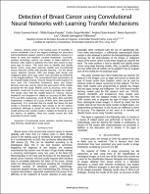| dc.contributor.author | Guevara-Ponce, Victor | |
| dc.contributor.author | Roque-Paredes, Ofelia | |
| dc.contributor.author | Zerga-Morales, Carlos | |
| dc.contributor.author | Flores-Huerta, Andrea | |
| dc.contributor.author | Aymerich-Lau, Mario | |
| dc.contributor.author | Iparraguirre-Villanueva, Orlando | |
| dc.date.accessioned | 2023-12-20T16:12:38Z | |
| dc.date.available | 2023-12-20T16:12:38Z | |
| dc.date.issued | 2023 | |
| dc.identifier.uri | https://hdl.handle.net/20.500.13067/2877 | |
| dc.description.abstract | Breast cancer is the leading cause of mortality in women worldwide. One of the biggest challenges for physicians and technological support systems is early detection, because it is easier to treat and establish curative treatments. Currently, assistive technology systems use images to detect patterns of behavior with respect to patients who have been found to have some type of cancer. This work aims to identify and classify breast cancer using deep learning models and convolutional neural networks (CNN) with transfer learning. For the breast cancer detection process, 7803 real images with benign and malignant labels were used, which were provided by BreaKHis on the Kaggle platform. The convolutional basis (parameters) of pre-trained models VGG16, VGG19, Resnet-50 and Inception-V3 were used. The TensorFlow framework, keras and Python libraries were also used to retrain the parameters of the models proposed for this study. Metrics such as accuracy, error ratio, precision, recall and f1-score were used to evaluate the models. The results show that the models based on VGG16, VGG19 ResNet-50 and Inception-V3 obtain an accuracy of 88%, 86%, 97% and 96% respectively, recall of 84%, 82%, 96% and 96% respectively, in addition to f1-score of 86%, 83%, 96% and 95% respectively. It is concluded that the model that shows the best results is Resnet-50, obtaining high results in all the metrics considered, although it should be noted that the Inception-V3 model achieves very similar results in relation to Resnet-50, in all the metrics. In addition, these two models exceed the 95% threshold of correct results. | es_PE |
| dc.format | application/pdf | es_PE |
| dc.language.iso | eng | es_PE |
| dc.publisher | SAI The Science and Information Organization | es_PE |
| dc.rights | info:eu-repo/semantics/openAccess | es_PE |
| dc.rights.uri | https://creativecommons.org/licenses/by/4.0/ | es_PE |
| dc.subject | Convolutional neural networks | es_PE |
| dc.subject | Transfer learning | es_PE |
| dc.subject | Deep learning | es_PE |
| dc.subject | Classification | es_PE |
| dc.subject | Breast cancer | es_PE |
| dc.title | Detection of Breast Cancer using Convolutional Neural Networks with Learning Transfer Mechanisms | es_PE |
| dc.type | info:eu-repo/semantics/article | es_PE |
| dc.identifier.journal | International Journal of Advanced Computer Science and Applications (IJACSA) | es_PE |
| dc.identifier.doi | https://doi.org/10.14569/IJACSA.2023.0140661 | |
| dc.subject.ocde | https://purl.org/pe-repo/ocde/ford#2.02.04 | es_PE |
| dc.source.volume | 14 | es_PE |
| dc.source.issue | 6 | es_PE |
| dc.source.beginpage | 574 | es_PE |
| dc.source.endpage | 580 | es_PE |


